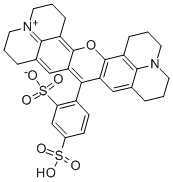All AbMole products are for research use only, cannot be used for human consumption.

Texas Red (Sulforhodamine 101) is an amphoteric rhodamine red fluorescent dye (excitation/emission: 586/605 nm). Texas Red is used extensively for investigating neuronal morphology and acts as acell type-selective fluorescent marker of astrocytes bothin vivoand in slice preparations
Furthermore, this fluorophore is used as an activity-dependent dye for monitoring regulated exocytosis. Alternate studies suggest that Sulforhodamine 101 can increase intrinsic neuronal excitability and long-lasting increases in evoked EPSCs in CA1 pyramidal neurons in hippocampal slices. Texas Red (Sulforhodamine 101) enhances evoked synaptic N-methyl D-aspartate receptor (NMDAR) currents which can be blocked by the antagonist, AP-5.
| Molecular Weight | 606.71 |
| Formula | C31H30N2O7S2 |
| CAS Number | 60311-02-6 |
| Form | Solid |
| Solubility (25°C) | DMSO 40 mg/mL Water 7 mg/mL |
| Storage | -20°C, protect from light |
[1] Hulsmann S, et al. Front Cell Neurosci. Limitations of Sulforhodamine 101 for Brain Imaging.
| Related Fluorescent Dye Products |
|---|
| PDMPO
PDMPO (Yellow/Blue DND-160) is a ratiometric probe for the determination of lysosomal pH for fluorescence imaging. PDMPO exhibits pH-dependent dual excitation and dual emission peaks. PDMPO produces blue fluorescence (Ex/Em=329 nm/440 nm) in weakly acidic organelles, and in more acidic lysosomes it becomes yellow fluorescence (Ex/Em=384 nm/540 nm). |
| Copper probe CF4
Copper probe CF4 (Copper fluor CF4) is a Cu+-specific fluorescent probe based on a rhodol dye scaffold. Copper probe CF4 (Copper fluor CF4) has high copper selectivity with a Kd value of 2.9×10-13 M, particularly over zinc and iron, as well as abundant cellular alkali and alkaline earth metals. Copper probe CF4 (Copper fluor CF4) is stable in a physiologically relevant pH regime between 6 and 8 (wavelengths of 415 nm for excitation and 660 nm for emission). Copper probe CF4 (Copper fluor CF4) can be used to study colon cancer. |
| Phalloidin-Fluor 647 Conjugate
Phalloidin-Fluor 647 Conjugate selectively binds to F-actins. Used at nanomolar concentrations, phalloidin derivatives are convenient probes for labeling, identifying and quantitating F-actins in formaldehyde-fixed and permeabilized tissue sections, cell cultures or cell-free experiments. |
| HBC530
HBC530 is a GFP fluorophore-like synthetic dye, with a structurally rigid electron acceptor and a strong electron donor. HBC is nonfluorescent in solution, and when combined with Pepper (RNA aptamer), HBC forms a tight complex and activates and emits bright fluorescence (Kd of ~3.5 nM). HBC emission peaks vary in different complexes and covers the spectrum from cyan to red. HBC can be used in the live cell imaging of RNA (Em/Ex = 530/485 nm). |
| 2',7'-dichlorodihydrofluorescein
2,7-Dichlorodihydrofluorescein (DCFH2) is a non-fluorescent reactive oxygen species (ROS) probe with an excitation wavelength of 485-500 nm and an emission wavelength of 515-530 nm. 2,7-Dichlorodihydrofluorescein is first hydrolyzed by intracellular esterases and then oxidized by ROS to generate non-biomembrane-permeable, highly fluorescent 2,7-dichlorofluorescein (DCF). 2,7-Dichlorodihydrofluorescein can undergo oxidation reactions with a variety of ROS (such as ·OH, H2O2, ONOO-, etc.) and is used to quantitatively detect the level of oxidative stress inside and outside cells. The fluorescence intensity of DCF is positively correlated with the ROS concentration. |
All AbMole products are for research use only, cannot be used for human consumption or veterinary use. We do not provide products or services to individuals. Please comply with the intended use and do not use AbMole products for any other purpose.


Products are for research use only. Not for human use. We do not sell to patients.
© Copyright 2010-2024 AbMole BioScience. All Rights Reserved.
